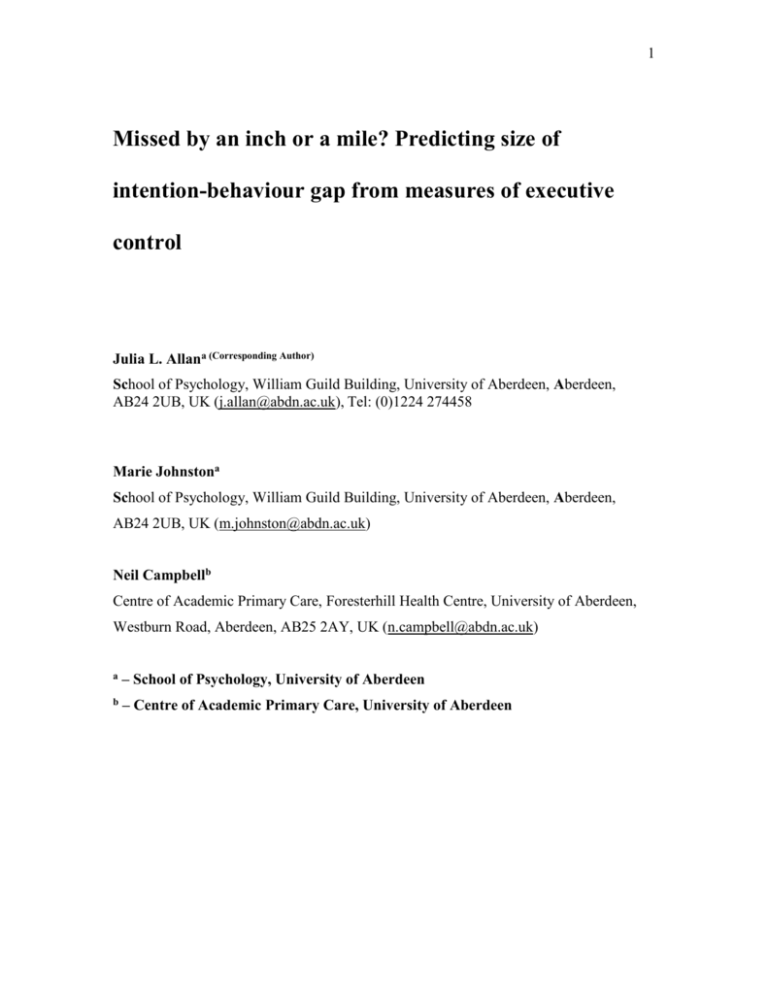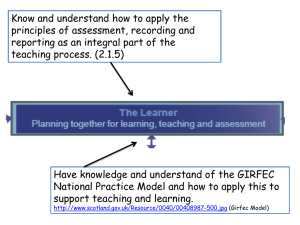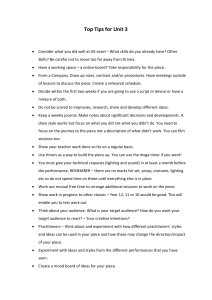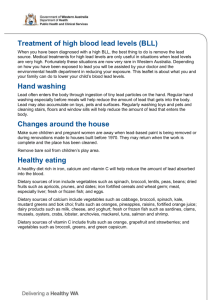I_B_gap_PandH_2nd_Preprint
advertisement

1 Missed by an inch or a mile? Predicting size of intention-behaviour gap from measures of executive control Julia L. Allana (Corresponding Author) School of Psychology, William Guild Building, University of Aberdeen, Aberdeen, AB24 2UB, UK (j.allan@abdn.ac.uk), Tel: (0)1224 274458 Marie Johnstona School of Psychology, William Guild Building, University of Aberdeen, Aberdeen, AB24 2UB, UK (m.johnston@abdn.ac.uk) Neil Campbellb Centre of Academic Primary Care, Foresterhill Health Centre, University of Aberdeen, Westburn Road, Aberdeen, AB25 2AY, UK (n.campbell@abdn.ac.uk) a – School of Psychology, University of Aberdeen b – Centre of Academic Primary Care, University of Aberdeen 2 Abstract Failing to achieve healthy intentions can have a direct impact on subsequent health. The extent of this impact is partially determined by the size of the discrepancy between intentions and behaviour, that is, on whether an unachieved behavioural target is missed by an inch or a mile. Over two studies, measures of ‘executive control’ ability were used to predict the size of the intention-behaviour gap for two dietary behaviours – eating fruits and vegetables and snacking. In Study 1, participants (n=50) reported intended dietary intake, completed objective and self-report measures of executive control ability and recorded actual dietary intake over 3 days with computerised diaries. Using multiple regression, general executive control ability was found to account for 16-23% of the variance in size of intention-behaviour gap for both dietary behaviours. In Study 2 (n=52), deviation from intentions about snacking was significantly related to individual differences in prepotent response inhibition. Overall, individuals with weak executive control ate less fruits and vegetables and more snacks than intended. Intention-behaviour ‘failures’ are not homogenous, but instead vary predictably with the availability of executive control resources. This suggests that individuals with large intention-behaviour shortfalls may benefit from interventions designed to reduce demands on executive control. Keywords: intention-behaviour gap, diet, executive control, snacking, fruits and vegetables 3 Introduction The determinants of health-relevant behavioural intentions are well researched (Armitage & Conner, 2001; Godin & Kok, 1996). However, if healthy intentions are to have a direct impact on health, they must be successfully translated into action. While most people know that they “should” eat plenty of fruits and vegetables and “should not” eat too many calorific snacks, turning healthy dietary intentions into action is notoriously difficult. Fewer than a quarter of people who embark on a healthy eating plan are still sticking to it 12 months later (Dansinger, Gleason, Griffith, Selker & Schaefer, 2004). Several post-intentional factors including temporal stability of intentions (Conner, Sheeran, Norman & Armitage, 2000; Conner & Godin, 2007), use of action plans or implementation intentions (Sniehotta, Scholz & Schwarzer, 2006; Verplanken & Faes, 1999; Gollwitzer, 1999) and individual differences in the ability to inhibit prepotent responses (Hall, Fong, Epp & Elias, 2008) have been shown to affect the number of individuals who succeed or fail in their stated intentions. Clearly however, eating a single chocolate bar while intending to avoid sugary snacks is not the same level of failure as eating several chocolate bars a day, so more insight into the intention-behaviour gap could be gained from studies of the magnitude and distribution of the gap itself. Specifically, when not actively engaged in behaviour change how far does the average individual meet, exceed or fall short of their stated intentions? By operationalising the gap to show its magnitude and distribution, it should be possible to differentiate between individuals who are sufficiently close to achieving their intentions to require little help and those who consistently fall far short of their stated intentions. Rather than trying to 4 predict behaviour or behaviour change, the present study focuses on the gap itself, that is on the discrepancy between intended and enacted action, and examines whether individual differences in the size of this gap can be predicted. Cognitive processes likely to determine the degree to which an individual can successfully implement their intended actions are the ‘executive control processes’. These higher-order cognitive processes are known to be involved in the planning, initiation, sequencing and monitoring of complex goal directed action (Royall et al, 2002), so variation in the efficiency of these processes is likely to relate to the degree to which an individual can successfully implement their intended actions. Executive control processes are conceptualised as abilities that individuals take with them into any given situation, and as they are not action-specific, they would be expected to play a general role in the implementation of intended actions in virtually any domain. Executive control is thought to be heavily involved in any behaviour requiring 1) planning and decision-making, 2) error monitoring and correction, 3) sequencing of actions, 4) complex actions, 5) inhibition of habitual responses or resistance to attractive stimuli, or 6) novel actions (Norman & Shallice, 1986), and so will almost certainly be important for key health behaviours such as maintenance of a healthy diet. If an intention to eat healthily is to be realised, healthy dietary behaviours must be planned, decisions must be made about which foods to avoid, dietary slips (errors) must be detected and compensated for to maintain progress towards the goal, actions must be sequenced so that chosen foods are purchased and prepared in advance of being eaten, habitual dietary behaviours must be suppressed if they are not in line with dietary intentions and temptations from enjoyable but intention incongruent foods resisted. 5 In the present pair of studies, the role of multiple executive control processes in the realisation of dietary intentions is examined. The concept of intention-behaviour gap is operationalised by directly estimating the size and distribution of the gap in two key dietary behaviours (eating fruits and vegetables and high calorie snacks), and the degree of successful intention-behaviour translation is predicted from measures of executive control. In order to get at the concept of gap, methodology typically used in intentionbehaviour research cannot be used. Specifically, while the intention-behaviour gap is typically assessed by examining the relationship between strength of intention about a target behaviour and subsequent performance of that behaviour, conceptualisation of the gap itself requires numerical quantification of both intentions and behaviour. To accomplish this, we propose using direct numerical estimation of intention and behaviour in order to quantify the size of the gap and to communicate this gap in terms that translate to observable phenomena (Gigerenzer & Edwards, 2003). Numerical estimation of intentions has been successfully used in several studies of intention-behaviour change to date (e.g. Sheeran, Webb & Gollwitzer, 2005). From a theoretical standpoint, numerical direct estimation allows us to measure the size and distribution of the intention-behaviour gap itself. Methodologically, it gives us a measure with ecological validity that captures peoples’ actual intentions, a measure that is concrete and easy for participants to comprehend and a measure that provides scores in units that are not subjective, so can be directly compared amongst participants. It is hypothesised that there will be considerable variation in the degree to which individuals realise their dietary intentions. In addition, it is expected that the discrepancy between intended and actual dietary behaviour (i.e. the gap itself) will be predictably 6 related to individual differences in executive control ability such that poor executive control will be associated with (i) eating fewer portions of fruits and vegetables than intended, and (ii) eating more unhealthy high-calorie snacks than intended. To clarify, it is not our contention that executive control will predict dietary behaviour per se, rather it is hypothesised that executive control will predict individual ability to eat as intended. Study 1 Objectively measured and self-reported executive control were used in a prospective design to predict discrepancy between intended and actual dietary behaviour over 3 days. Participants: 50 students at the University of Aberdeen participated (19 male, 31 female, mean age 22 years) and received course credit for participation. The sample size of 50 was determined using GPOWER (Faul & Erdfelder, 1992), for a multiple regression analysis with 4 predictor variables, alpha=0.05, power =0.90, and a large (0.35) effect of executive function on change in consumption of fruits and vegetables and snacks (Hall et al, 2008). All participants gave informed consent prior to participation. The study obtained ethical approval from the University of Aberdeen Ethics Committee and was carried out in accordance with ethical guidelines. Procedure / Materials Measurement of Intention: Participants rated their intentions on 6 different behaviours to conceal the focus on diet - eating fruits and vegetables, eating high calorie snacks, studying, non-essential shopping, watching TV, and exercising. Participants 7 were asked to quantify their intentions for each behaviour on each of the three days following the test session (e.g. On Friday, how many snacks do you intend to consume?). The total number of portions of fruits and vegetables and snacks participants reported intending to consume over the 3 days were the measures of intention. Objective measurement of executive control: Go/NoGo task (inhibition; replication of Hall et al, 2008). Participants were shown a series of letters of the alphabet on a computer screen, each separated from the next by a 1000ms fixation. They were instructed to press a key as quickly as possible (‘go’) if the letter was lower case and to refrain from making any response (‘no-go’) if the letter was upper case. Trials were presented in 8 counterbalanced blocks of 60. ‘Go’ trials (i.e. lower case letters) predominated in half the blocks (at a ratio of 4-1) and ‘NoGo’ trials (i.e. upper case letters) predominated in the other half. Reaction times to make a ‘go’ response when ‘go’ trials predominated were subtracted from reaction times to make a ‘go’ response when ‘no-go’ trials predominated to find the time cost associated with inhibiting an incorrect but prepotent response. High scores (i.e. a greater time-cost) indicate weaker inhibition. Tower task (planning; Delis, Kaplan & Kramer, 2001). Participants were asked to move a set of discs from a ‘start’ position to a predefined ‘goal’ position, using as few moves as possible and without placing larger discs on top of smaller discs. The 9 trials ranged in difficulty from 1 to 26 moves. The task was scored out of 30 according to the number of moves required to solve each trial. Lower scores indicate poorer planning. Verbal fluency task (cognitive flexibility; Delis et al, 2001). Participants named as many words as possible in 60 seconds that (a) began with a particular letter (repeated 8 with F, A, and S) or (b) fitted into a particular category (repeated twice with animals and boy’s names). Low numbers of correct items indicates poor cognitive flexibility. Trail Making task (task switching; Delis et al, 2001). Participants were asked to connect randomly arranged numbers and letters in both numerical and alphabetical order, switching from number to letter alternately (i.e. 1-A-2-B-3-C etc). Higher scores (i.e. longer completion times) indicate poorer attentional switching. Self-reported executive control: Dysexecutive (DEX) Questionnaire (Wilson, Alderman, Burgess, Emslie, & Evans, 1996). A 20 item questionnaire asking respondents about behaviours indicative of executive dysfunction in everyday life. Scored from 0-80, higher scores are indicative of weak executive control. Measurement of Behaviour: Computerised diaries (Dell Axim X51s) were programmed to give an audible alarm 3 times a day for 3 consecutive days asking participants to fill in how much of each of the 6 intended behaviours they had performed since the last alarm (‘Pocket Questionnaire’ program; University of Aberdeen, 2006). Diary entries were requested at 12 noon (report of the morning’s behaviours), 5pm (report of the afternoon’s behaviours) and 11am the following day (report of the previous evening’s behaviours). Making multiple reports over the measurement period minimised the time between behaviour occurring and the report being made which was expected to reduce retrospective report errors (Reis, 1994). Participants took part on 2 week and 1 weekend day to make the measurement period as representative as possible. Analysis: For each participant, the intention-behaviour gap was calculated directly by subtracting the intended from the actual number of portions consumed for both fruits and vegetables and snacks. The use of difference scores has been criticised in 9 the behaviour change literature because difference scores typically represent change in the same variable over time. However, the discrepancy scores used in the present study do not reflect change in one variable over time, rather they represent the intentionbehaviour ‘gap’ itself, and are calculated from two different variables – numerical ratings of intentions and reported eating behaviour. This approach allows us to quantify the extent of the ‘gap’ by directly estimating the distance between intended and actual eating behaviour. Multiple regression was used to predict the gap between intended and actual consumption of each food from measures of executive control. Results One participant was excluded because their diary contained several extreme and implausible scores. The characteristics of the remaining 49 participants and study data are summarised in Table 1. [Insert Table 1 here] 5.2% of the diary data were missing. Pairwise deletion was used to omit from analysis intention ratings for the time periods corresponding to missing diary entries to ensure intention-behaviour discrepancy scores with high correspondence. All participants completed all of the executive tasks and answered all of the questionnaire items. The Theory of Planned Behaviour (Ajzen, 1991) predicts that behaviour is partially determined by intentions. In line with this, regression analyses showed that intentions explained 54% of the variance in fruit and vegetable consumption (r2=.53, F(1, 48)=52.72, p<0.01) and 12% of the variance in snacking (r2=.12, F(1, 48)=6.12, p=0.02). 10 (1) Direct Estimation of Dietary Intention-Behaviour Gaps As can be seen in Figures 1a and 1b, the distribution of intention-behaviour gaps for fruit and vegetable consumption was centred around zero indicating that people in this sample commonly achieved their intended fruit and vegetable consumption levels. In contrast, the average intention-behaviour gap for snacks was 2.2, indicating that in this sample, individuals typically ate two more snacks than intended. [Insert Figures 1a and 1b here] There was a significant correlation between intention-behaviour gap for fruits and vegetables and for snacking (r (49) = - .51, p<0.01) demonstrating that those who ate less fruits and vegetables than intended also tended to eat more snacks than intended. Interestingly, there was not a significant correlation between the behaviours themselves (r (49)= -.12, p=0.41) or between intentions about each behaviour (r (49)= .23, p=0.12). (2) Dietary intention-behaviour gaps and objectively measured executive control As multi-collinearity prevented the simultaneous entry of all 4 executive tasks as predictors in the same multiple regression model, principal components analysis was used to derive scores on the underlying factors captured by the four executive tasks. Extracting factors with eigenvalues >0.7 (Joliffe’s recommendation) resulted in a 2-factor solution. These two factors were rotated using oblique rotation (direct oblimin). After rotation, three of the four executive tasks (tower task, verbal fluency and trail making) clearly loaded onto the same factor (factor 1 – ‘switching/flexibility’) and the fourth task (Go/NoGo) onto a second factor (factor 2 – ‘inhibition’). Each participant’s scores on 11 these two factors were retained from the principal components analysis and used in the subsequent analyses to predict intention-behaviour gap for fruit and vegetable consumption and snacking. Weak executive control was associated with eating less fruits and vegetables than intended. The two executive control factors (‘switching / flexibility’ and ‘inhibition’) when entered simultaneously into a multiple regression analysis with fruit and vegetable intention-behaviour gap as the outcome explained a statistically significant 18% of the variance (r2= .18, F (2, 48) =5.12, p=0.01). While the switching / flexibility factor contributed significantly to this (β=1.46, p= .008, 95%CIs: .40 to 2.51), the inhibition factor did not (β= .57, p= .286, 95%CIs: -.49 to 1.62). Consequently, switching/flexibility was entered alone into a simple regression model and was found to explain 16% of the variance in intention-behaviour gap for fruit and vegetable consumption (r2= .16, F(1, 48) =9.04, p= 0.004). The two executive control factors (‘switching/flexibility’ and ‘inhibition’) entered simultaneously into a multiple regression analysis with snacking intention-behaviour gap as the outcome explained a statistically significant 22% of the variance (r2= .22, F (2, 48) =6.45, p=0.003). While the switching / flexibility factor contributed significantly to this (β= -1.35, p= .01, 95%CIs: -2.35 to -.34), the inhibition factor did not (β= -.93, p= 0.07, 95%CIs: -1.93 to .07). Consequently, switching/flexibility was entered alone into a simple regression model and was found to explain 16% of the variance in intentionbehaviour gap for snacking (r2= .16, F(1, 48) =8.95, p=0 .004). (3) Dietary intention-behaviour gaps and self-reported executive control 12 DEX questionnaire scores (i.e. frequency of self-reported symptoms of executive dysfunction) explained a statistically significant 17% of the variance in intentionbehaviour gap for fruit and vegetable consumption (r2= .17, F (1, 48) =9.83, p<0.01), and 23% of the variance in intention-behaviour gap for snacking (r2= .23F (1, 48) =14.06, p<0.01). Again, weak executive control was associated with eating less fruits and vegetables and more high calorie snacks than intended. Lack of effect of ‘inhibition’: As the factor ‘inhibition’ did not explain a significant amount of variance in intention-behaviour gap for either snacking or fruit and vegetable consumption (in direct contrast to the findings of Hall et al, 2008), the possibility that the inhibitory task (the Go/NoGo) had failed to adequately capture participant’s inhibitory ability was investigated. Scores on the Go/NoGo task did not correlate significantly with scores on items from the DEX questionnaire known to load onto an “inhibitory” factor (Mooney et al, 2006; r (49) = - .19, p=0.17) indicating that the two measures of 'inhibition' were not measuring the same process. Weak inhibition, as reported in the DEX, was associated with eating less fruits and vegetables than intended (r(49)= -.30, p=0.04) and eating more snacks than intended (r(49)=.36, p=0.01) in line with the present hypotheses. Discussion Both objective and self-report measures of the planning, switching and flexibility components of executive control explained significant amounts of variance in intentionbehaviour gap for fruit and vegetable consumption and snacking. Individuals with good executive control were more likely to achieve or better their dietary intentions (by eating 13 as many or more portions of fruits and vegetables as intended and as many or fewer snacks than intended) than those with poor executive control. However, the task used to measure inhibition in the present study (the Go/NoGo) did not explain any variance in intention-behaviour gap for fruit and vegetable consumption and only a small and nonsignificant amount of variance in intention-behaviour gap for snack consumption. This stands in contrast to the results of other studies which successfully predict intentional dietary behaviour from performance on the Go/NoGo task (Hall et al, 2008). To investigate this, a second study was performed, predicting deviation from dietary intentions from two different measures of inhibitory ability – the Go/No Go task used in Study 1 and the Stroop colour-word task. If, as hypothesised, inhibition is important for dietary intention-behaviour translation but the Go/NoGo task used in Study 1 does not capture the relevant inhibitory ability, scores on an alternative measure of inhibition should predict size of intention-behaviour gap where Go/NoGo scores do not. Study 2 Two alternative measures of inhibition – a Go/NoGo task and a Stroop task - were used to predict discrepancy between intended and actual snacking over a 24 hour period. Participants: 64 students at the University of Aberdeen participated in the first phase of the study, and of these, the 52 (49 female, 3 male, mean age 21 years) reporting intentions to avoid high calorie snack foods over the following 24 hours were enrolled in the second phase of the study and received course credit for participation. All participants gave informed consent prior to participation. The study obtained ethical 14 approval from Aberdeen University School of Psychology Ethics Committee and was carried out in accordance with ethical guidelines. Procedure / Materials Measurement of Intention: All individuals completed a questionnaire on lifestyle and consumer behaviour and participants were selected on the basis of agreement or strong agreement with two items about snacking (α=.83): “Over the next 24 hours, I intend to avoid high-calorie snacks between meals”, and the alternately worded “Over the next 24 hours, I want to avoid high-calorie snacks between meals” (5point scoring from ‘Strongly Agree’ to ‘Strongly Disagree’). For the purposes of the study, participants were given a definition of ‘high calorie snacks’ based on a list of ‘noncore’ foods, that is foods that are surfeit to daily requirements, and are not any of the main food groups recommended for daily consumption (Kelly, King, Bauman, Smith & Flood, 2007). Healthy high calorie foods (e.g. seeds) were removed from the categorisation to leave crisps, savoury snacks (such as cheddars and twiglets), chocolate, sweets, cakes, biscuits, pies, and pastries. Participants were instructed to base their answers about ‘snacking’ during the study solely on the foods specified in the above list. Following completion of the questionnaire, each participant completed two measures of inhibitory capacity; Go/NoGo task: Identical to that used in Study 1, where high scores (i.e. a greater time-cost) indicate weaker inhibition. Stroop Colour-Word interference task (Delis, Kaplan & Kramer, 2001): Participants named aloud the colour of both incongruently coloured colour words (e.g. 15 the word “red” printed in blue ink) and coloured patches. The difference in time between the two conditions was taken as a measure of prepotent response inhibition with higher scores (i.e. longer completion times) reflecting poorer inhibition. Measurement of Behaviour: Participants completed a 24 hour dietary monitoring task where they were asked to pay particular attention to everything they ate and to note consumption of any foods from the list of ‘high calorie snacks’ described above. After 24 hours, participants logged onto a website which reminded them of the list of high calorie snacks and asked them to indicate how many of each type of snack they had consumed in the preceding 24 hours. All participants received an email reminder to complete this task after 12 hours, and a further reminder if 24 hours elapsed with no response. All participants completed the task within 28 hours. Analysis: As all participants indicated intentions to avoid consuming the specified foods over the 24 hour measurement period, deviation from this intention (i.e. consumption of foods from the list of snacks) constituted an intention-behaviour gap. For each participant, a score reflecting the size of the intention-behaviour gap (i.e. how many snacks from the list they reported consuming over the 24 hour period) was recorded. This score was then correlated with scores on the two different inhibitory tasks. Results On average, participants reported consuming 1.5 (SD=1.3, range=0-5) snacks from the specified list over the 24 hour measurement period. Number of snacks consumed correlated significantly with performance on the Stroop task (r= .30, p=0.03) indicating that those with weaker inhibition had a larger intention-behaviour gap for snacks than 16 those with stronger inhibition. However, performance on the Go/NoGo task once again did not correlate significantly with size of intention-behaviour gap for snacks (r= .18, p=0.19), and showed virtually no correlation with performance on the other inhibitory measure - the Stroop task (r= -.002, p=0.98). These results support the hypothesis that an element of inhibitory control is important for the translation of dietary intentions into action, but that this is not captured by the Go/NoGo task used in the present study. General Discussion The present study used measures of executive control ability to predict intentionbehaviour gap for fruit and vegetable consumption and snacking. As expected, individuals differed considerably in the degree to which they realised their stated dietary intentions, with some individuals exceeding their intentions, some achieving their intentions and others falling short of their intentions by a considerable margin. Individuals who performed well on measures of planning, task switching and cognitive flexibility were more likely than others to achieve or better their dietary intentions (by eating as much or more fruits and vegetables as intended and as many or fewer snacks than intended; Study 1), and those who performed well on a measure of response inhibition were less likely than others to deviate from their stated dietary intentions (Study 2). These results suggest that having poor executive control is detrimental to attempts to translate healthy intentions into healthy behaviour. The intention-behaviour gap in Study 1 was larger for snacks than for fruits and vegetables. Intentions about fruits and vegetables explained a substantial 54% of the variance in consumption, while intentions about snacks only explained 12% of the 17 variance in subsequent snacking. The marked difference in variance explained may reflect the fact that snacking tends to be less intentional (as it is supplementary to the planned diet) and may therefore be more influenced by appetitive and environmental factors, and less by cognitions than fruit and vegetable consumption. The strong relationship between fruit and vegetable intentions and behaviour may be partly attributed to three aspects of the present methodology. Firstly, Gigerenzer & Hoffrage (1999) have argued that people are developmentally and evolutionarily prepared to think in natural frequencies, so direct numerical estimation may have led to more accurate estimation of intentions than is typically found in studies using intentionstrength ratings. Secondly, by collecting consumption information with direct numerical estimation at multiple time points over the 3-day measurement period, (a) precise correspondence between the intention and behaviour measures was ensured, and (b) the time between behaviour occurring and being reported was minimised, helping to maximise accuracy of reports. Thirdly, because participants were asked to think about the time period of the study and give intentions separately for each of the three measurement days, context could be taken into account. This meant that more realistic, flexible and contextually appropriate intentions could be generated, which in turn would be more likely to accurately reflect subsequent behaviour Which executive control processes are important? Four objectively measured components of executive control, (planning, task-switching, cognitive flexibility, and inhibition) were significantly related to the size of dietary intention-behaviour gap over two studies. Why should each of these component processes be important for dietary intention-behaviour translation? 18 Planning improves the likelihood that dietary goals will be achieved by linking the planned action to a situational cue (Gollwitzer, 1999). When this cue is encountered, the planned action is triggered with little need for in situ deliberation, improving the chances that dietary goals will be achieved (Armitage, 2004). Planning in the health domain is typically conceptualised as the ‘holding of a plan’, and whether individuals spontaneously generate plans (‘action planning’) or are given structured plans (‘implementation intentions’), having a plan is generally beneficial to goal attainment. Planning in the present study was conceptualised as an executive process, and as such was measured in terms of ‘ability to plan’. Recent data from our lab suggests that planning ability measured in this way moderates the beneficial effect of simply having a plan, as ‘good planners’ seem to produce more effective plans spontaneously and therefore have less capacity to benefit from the provision of structured plans (Allan, Sniehotta, Johnston & Campbell, in submission). Flexibility is important in goal pursuit because flexible thought allows the generation of multiple different ways of realising intentions and multiple alternative solutions to problems that arise. As has been highlighted in the literature on coping planning, being able to flexibly generate alternative courses of action is beneficial to successful goal attainment (Sniehotta et al, 2006). Task switching ability reflects the reconfiguration of current task set to allow a different task to be undertaken (Monsell, 2003). As habitual task sets (i.e. those that have been repeatedly activated in the past) tend to be automatically activated in situations where the goal is novel, difficult or unappealing (Monsell, 2003), good task switching is required to overcome this and initiate an alternative and goal-congruent task set. Task 19 sets can be established in advance of need so that when the target stimulus occurs, the necessary behaviour is largely cue driven and does not require any further ‘act of intention’ (Logan, 1985). Consequently, efficient switching would be expected to reduce the demands on other executive control processes during implementation of intended actions by circumventing the need for in situ effortful control when cues to intended foods were encountered. Inhibition of prepotent responses refers to the ability to suppress dominant or automatic responses if these responses are not in line with current task aims. Behavioural responses that left unchecked would contradict dietary intentions (e.g. eating biscuits when on a diet) must be suppressed if dietary intentions are to be successfully translated into action. In the present studies, inhibitory ability did not predict size of dietary intention-behaviour gap in Study 1 when a Go/NoGo task was used to measure inhibition (in line with Wong & Mullan, 2009 but in contrast to Hall et al, 2008), but did predict intention-behaviour gap for snacking in Study 2 when an alternative measure of inhibition (the Stroop task) was used. As scores on the two inhibitory tasks did not correlate with each another, it seems that each task may have captured a different facet of inhibition with only the facet captured by the Stroop task being relevant for dietary intention-behaviour translation. Low or non-existent correlations between different measures of inhibition are commonly reported in the literature (see Friedman & Miyake, 2004 for an overview), and may be partly attributed to the problem of task impurity. No inhibitory task provides a pure measure of inhibition, rather different tasks measure different forms of inhibition with different types of stimuli, and consequently scores will differ from task to task depending on the non-inhibitory demands. When the processes 20 tapped by the Go/NoGo and Stroop tasks used in the present work are considered, it becomes apparent that there are clear differences between the two. Both tasks purport to measure prepotent response inhibition, that is, the active inhibition of responses that are not in line with current aims. In the Go/NoGo task, the immediate task aim changes on a trial by trial basis depending on the identity of the stimulus presented. Participants are instructed to make a response to lower-case letters and with-hold a response to capital letters, so the task aim differs from trial to trial depending on the identity of the letter presented. In the Stroop task in contrast, there is one clear task aim that applies to all stimuli encountered – name the colour of the stimulus. This means that performance on the Stroop depends upon an individual’s ability to apply a consistent behavioural standard across a range of different stimuli, whereas performance of the Go/NoGo depends more upon ability to keep multiple rules in working memory and apply them appropriately across differing situations. At an intuitive level, the consistent application of one dietary intention (avoid snacks) to all dietary behaviour seems more closely related to the type of inhibition measured by the Stroop task, potentially explaining the difference in results seen between the two inhibitory tasks. Strengths of the present study With the direct estimation approach, it was possible not only to see who succeeded and who failed to realise their intentions, but also to differentiate between those who were close and those who failed by a considerable margin. These differences are important to include in studies of dietary behaviour because the health consequences of eating one snack too many and snacking to excess are considerably different. 21 By using a computerised diary with periodic reports throughout the measurement period it is likely that retrospective report errors were minimised in this study. In addition, using a 3 day diary rather than a 24 hour diary it is likely that the measurement period was representative of the participant’s normal diet. Finally, using both self-reported and objective measures of executive control allowed a stronger test of the hypothesised relationship between dietary intentionbehaviour gap and executive control. The two sets of results told a very similar story, affording greater confidence in the overall conclusion. Limitations of the present study There were three identified limitations to the present study. Firstly, the sample size was calculated from a single effect size in the literature as there was only one study available on executive control and intentional dietary behaviour when the study was designed. Consequently, it is possible (although unlikely given the size of the effects detected in the present paper) that the study was underpowered to detect an effect of inhibition. Secondly, the sample came from the student population and so the findings need to be replicated in other samples of young adults to ensure generalisability. Thirdly, frequent diary entries about food consumption may have served to periodically remind participants of their stated intentions, distorting the true intention-behaviour relationship. A large distortion is unlikely however as the experimental interest in diet was concealed until the end of the study. Each time a participant made a diary entry they were asked about multiple behaviours (not just food) under the guise of an overview of their typical day. Future Directions 22 If intention-behaviour translation is generally more successful in those with good executive control, then future studies could look at whether intention-behaviour translation rates in individuals attempting behaviour change could be improved by either (a) trying to improve individual levels of executive control, or by (b) trying to reduce the demands on executive control during behaviour change. A good example of a strategy that may operate at either level is the use of ‘implementation intentions’ or ‘If-Then’ plans (Gollwitzer, 1999). Implementation intentions are concrete plans that take the form “I intend to do X when I encounter Y”, and have been shown to have a medium to large effect on the attainment of goals (Armitage, 2004; Gollwitzer & Sheeran, 2006; Verplanken & Faes, 1999). Implementation intentions allow a strategic shift away from conscious, effortful control (i.e. from a cognitive state where the demands on executive control are considerable) to cue driven behaviour that is automatically elicited when the elements specified in the plan are encountered. As automatic behaviour can largely operate without executive control (Norman & Shallice, 1986), implementation intentions would be expected to greatly reduce the demands on executive control. If implementation intentions do reduce the demands on executive control, then we would expect them to benefit everyone (by making the task easier), and to be more effective in individuals with weak executive control. Supporting the latter assertion is research showing that implementation intentions are more beneficial than normal in individuals with executive control deficits (people with frontal lobe damage; Lengfelder & Gollwitzer, 2001), and have been shown to help reduce resource depletion experienced during performance of an executive task (Stroop task; Webb & Sheeran, 2003). 23 In terms of theoretical development, future research should address how executive control relates to other processes known to influence intention-behaviour translation, e.g. perceptions of control, self-efficacy, spontaneous use of action plans, and past behaviour; for example it may be that past behaviour or self-efficacy predict behaviour and success in behaviour change because they are in turn determined by executive control. It would also be worthwhile to explore why some measures of inhibitory control predict failure to implement intentions while others do not, and investigate whether it is possible to enhance the relevant aspects of inhibition through appropriate intervention. In conclusion, the present study succeeded in quantifying the magnitude of the intention-behaviour gap for two key dietary behaviours and identified executive control strength as an important factor in the translation of dietary intentions into action. Individuals with weak executive control ate more unhealthy snacks and less fruits and vegetables than intended, probably because they were less well equipped for the effortful process of intention-behaviour translation than those with stronger executive control. References Ajzen, I. (1991). The theory of planned behaviour. Organizational Behaviour and Human Decision Processes, 50, 179–211. Allan, J.L., Johnston, M., & Campbell, N. (under review). Unintentional eating: what determines goal incongruent chocolate consumption? Appetite. 24 Allan, J.L., Johnston, M., Campbell, N. & Sniehotta, F.F. (in submission). Planning ability moderates the beneficial effect of action plans and implementation intentions. Armitage, C.J. (2004) Evidence that implementation intentions reduce fat intake: A randomized trial. Health Psychology, 23, 319-323. Armitage, C.J. & Conner, M. (2001). Efficacy of the theory of planned behaviour: A meta-analytic review. British Journal of Social Psychology, 40, 471-499. Conner, M. & Godin, G. (2007). Temporal stability of intentions as a moderator of intention-health behaviour relationships. Psychology & Health, 22, 875-896. Conner, M., Sheeran, P., Norman, P., & Armitage, C.J. (2000). Temporal stability as a moderator of relationships in the theory of planned behaviour. British Journal of Social Psychology, 39, 469-493. Dansinger, M.L., Gleason, J.A., Griffith, J.L., Selker, H.P. & Schaefer, E.J. (2004). Comparison of the Atkins, Ornish, weight watchers and zone diets for weight loss and heart disease risk reduction: A randomized trial. Journal of the American Medical Association, 293, 43-53. Delis, D., Kaplan, E. & Kramer, N. (2001). Delis-Kaplan Executive Function System. Odessa, Florida: Psychological Assessment Resources. 25 Faul, F., Erdfelder, E. (1992). GPOWER: Apriori, post-hoc, and compromise power analyses [computer program]. Bonn: Bonn University, Department of Psychology. Friedman, N.P., & Miyake, A. (2004). The relations among inhibition and interference control functions: A latent variable analysis. Journal of Experimental Psychology: General, 133, 101-135. Gigerenzer, G. & Edwards, A. (2003). Simple tools for understanding risks: from innumeracy to insight. British Medical Journal, 327, 741-744. Gigerenzer, G., & Hoffrage, U. (1999). Overcoming difficulties in Bayesian reasoning: A reply to Lewis and Keren (1999) and Mellers and McGraw (1999). Psychological Review, 106, 425-430. Godin, G., & Kok, G. (1996). The theory of planned behaviour: A review of its applications to health-related behaviours. American Journal of Health Promotion, 11, 87–98. Gollwitzer, P.M. (1999). Implementation intentions: Strong effects of simple plans. American Psychologist, 54, 493-503. 26 Gollwitzer, P.M. & Sheeran, P. (2006). Implementation intentions and goal achievement: a meta-analysis of effects and processes. Advances in Experimental Social Psychology, 38, 69-119. Hall, P. A., Fong, G. T., Epp, L. J., & Elias, L. (2008). Executive function moderates the intention-behavior link for physical activity and dietary behavior. Psychology & Health, 23, 309-326. Kelly, B., King, L., Bauman, A., Smith, B.J., & Flood, V. (2007). The effects of different regulation systems on television advertising to children. Australian & NZ Journal of Public Health, 31, 340-343. Lengfelder, A. & Gollwitzer, P.M. (2001). Reflective and reflexive action control in patients with frontal brain lesions. Neuropsychology, 15, 80-100. Logan, G.D. (1985). Executive control of thought and action. Acta Psychologica, 60, 193-210. Monsell, S. (2003). Task switching. Trends in Cognitive Sciences, 7, 134-140. Mooney, B., Walmsley, C. & McFarland, K. (2006). Factor analysis of the self-report dysexecutive (DEX-S) questionnaire. Applied Neuropsychology, 13, 12-18. 27 Norman, D.A. & Shallice, T. (1986). Attention to action: Willed and automatic control of behaviour (Revised reprint of Norman & Shallice, 1980). In R.J. Davidson, G.E. Schwartz & D. Shapiro (Eds.), Consciousness and Self-Regulation: Advances in Research and Theory (pp1-18). Plenum Press. Reis, H.T. (1994). Domains of experience: Investigating relationship processes from three perspectives. In R. Erber & R. Gilmore (Eds.) Theoretical frameworks in personal relationships (pp87-110). Mahwah, NJ: Erlbaum. Royall, D.R., Lauterbach, E.C., Cummings, J.L., Reeve, A., Rummans, T.A., Kaufer, D.I., LaFrance, W.C., & Coffey, C.E. (2002). Executive control function: a review of its promise and challenges for clinical research. Journal of Neuropsychiatry and Clinical Neuroscience, 14, 377-405. Sheeran, P. (2002) Intention-behaviour relations: A conceptual and empirical review. European Review of Social Psychology, 12, 1-36. Sheeran, P., Webb, T.L., & Gollwitzer, P.M. (2005) The interplay between goal intentions and implementation intentions. Personality and Social Psychology Bulletin, 31, 87-98. 28 Sniehotta, F.F., Scholz, U., & Schwarzer, R.(2006). Action plans and coping plans for physical exercise: A longitudinal intervention study in cardiac rehabilitation. British Journal of Health Psychology, 11, 23-37. University of Aberdeen (2006) Pocket Questionnaire [computer program]. University of Aberdeen Data Management Team. Verplanken, B., Faes, S. (1999), Good intentions, bad habits and the effects of forming implementation intentions on behaviour and cognition. European Journal of Social Psychology, 29, 591-604. Webb, T.L. & Sheeran, P. (2003). Can implementation intentions help to overcome egodepletion? Journal of Experimental Social Psychology, 39, 279-286. Wilson, B.A., Alderman, N., Burgess, P.W., Emslie, H., & Evans, J.J. (1996). Behavioural assessment of the dysexecutive syndrome. Bury St Edmunds, UK: Thames Valley Test Company. Wong, C. & Mullan, B. (2009) Predicting breakfast consumption: An application of the Theory of Planned Behaviour and the investigation of past behaviour and executive function. British Journal of Health Psychology, 14, 489-504. 29 Table 1: Sample characteristics / data summary ________________________________________________________________________ n 49 Mean age in years (SD) 22 (4.9) Gender 19M, 30F Mean years of formal education (SD) 15 (3.0) Mean (SD) Go/NoGo task RT (cost of effortful initiation, in ms) 57.2 (59.7) Mean (SD) Trail making switch condition completion time (seconds) 62.4 (17.4) Mean (SD) Tower task overall score ( /30) 17.9 (4.7) Mean (SD) Verbal fluency score 77.8 (16.7) Mean (SD) DEX score ( /80) 24.8 (11.9) Mean (SD) intended portions of fruits and vegetables 9.5 (4.6) Mean (SD) portions of fruits and vegetables consumed 9.0 (5.6) Mean (SD) intended number of snacks 3.3 (2.7) Mean (SD) number of snacks consumed 5.5 (3.7) Mean (SD) intention-behaviour gap for fruits and vegetables * -0.5 (3.9) Mean (SD) intention-behaviour gap for snacks* 2.2 (3.8) ________________________________________________________________________ *Assuming that successful realisation of intentions is eating your intended portions of fruits and vegetables or MORE fruits and vegetables, eating your intended number of snacks or FEWER snacks, then success is indicated by a positive fruit and vegetables discrepancy score, and a negative snack discrepancy score. 30 Figures 1a and 1b: Distribution of intention-behaviour discrepancy scores for (i) fruit and vegetable consumption, and (ii) snack consumption






